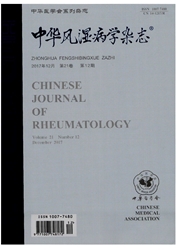

 中文摘要:
中文摘要:
目的比较干扰素诱导蛋白4(IFIT4)、蛋白激酶(PRKR)在不同类型狼疮肝损害患者的表达差异,及不同类型狼疮肝损害的临床表现及免疫学指标,分析总结其各自特点。方法将符合狼疮性肝损害诊断的62例患者分为单纯肝酶升高组、单纯胆酶升高组和肝酶胆酶均升高组,再选取同期62例无狼疮性肝损害患者作对照,收集其相关临床数据及外周血白细胞IFIT4、PRKR基因表达进行比较分析。数据采用r检验、方差分析及Pearson或Spearman相关分析。结果①胆酶升高组易并发皮肤黏膜损害(x2=5.625,P=0.018)、狼疮肾炎坼=5.631,P=0.019),出现贫血及血小板减少(99±21,P=0.028;81±45,P=0.004)等血液系统损害,其C反应蛋白(CRP)(33±43,P=0.004),nRNP(x2=4.862,P=0.027)和抗SSA抗体(x2=8.087,P=0.004)阳性率均明显高于其他组;②系统性红斑狼疮性肝损害组抗核糖体蛋白(Rib)抗体阳性率明显高于无SLE性肝损害组(x2=19.542,P=0.000);③IFIT4在不同组中表达差异无统计学意义,蛋白激酶在单纯胆酶升高组中明显高表达(F=3.54,P=0.018),并与γ-谷氨酰转氨酶(γ-GGT)、碱性磷酸酶呈正相关(r=0.34,P〈0.05;r=0.3,P〈0.05)。结论不同类型肝损害有着不同的临床和实验室特点,蛋白激酶在单纯胆酶升高组明显高表达。
 英文摘要:
英文摘要:
Objective To analyze the expression of IFIT4, PRKR and investigate the clinical and immunology features of different types of liver involvement in patients with systemic lupus erythematosus (SEE). Methods Clinical data of 62 cases of SLE with liver damage and 62 cases of SLE without liver damage were collected. Peripheral venous blood samples were obtained and total RNA were extracted and transcribed into cDNA. Sybr green dye based real-time quantitative PCR method was used to compare the expression levels of IFIT4, PRKR in patients with SLE. Clinical parameters were analyzed by ANOVA, Chi-square test, Pearson's or Spearman's test. Results (1) The increase of γ-GT or ALP was correlated with rash and oral ulcer (x2= 5.625, P=0.018), lupus nephritis (x2=5.631, P=0.019), anemia, thrombocytopenia (99±21, P=0.028 ; 81 ± 45, P=0.004), CRP (33±43, P=0.004). The positive rate of nRNP (X2=4.862, P=-0.027) and SSA (x2=8.087, P=-0.004) was higher in patients with liver damage than other groups ; (2) The positive rate of anti-Rib antibody in SLE with liver damage was significantly higher than SLE without liver damage (X2=19.542, P=0.000); (3) There was no difference in the expression of IFIT4 among these groups, but higher expression of PRKR was detected in the group of patients with increased γ-glutamyl transpeptidase (γ-GT) or ALP(F=3.54, P=0.018). Conclusion The different types of liver damage in SLE patients have different clinical and immunology characteristics. The expression of PRKR is higher in patients with increased γ-GT or ALP.
 同期刊论文项目
同期刊论文项目
 同项目期刊论文
同项目期刊论文
 期刊信息
期刊信息
